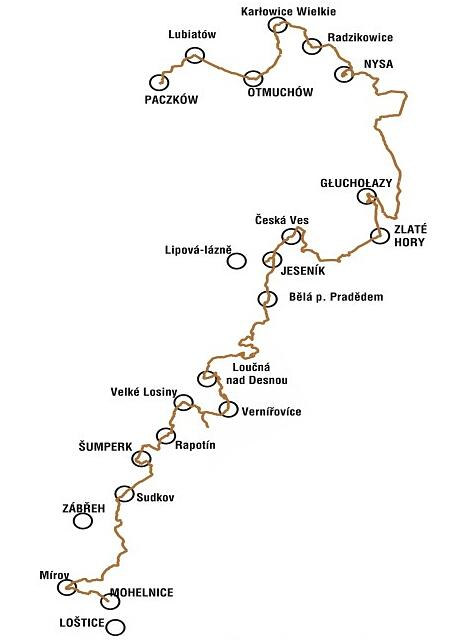Witches' Trail - Opole stories from the 17th century
The Witches' Trail in Opole is undoubtedly one of the region's most intriguing tourist attractions. We invite you on a bicycle tour during which you will not only experience active recreation in beautiful natural surroundings, but also explore sites associated with the famous witch trials that took place centuries ago in the Duchy of Nysa.

The Witches' Trail - Opole's tragic history and a tourist attraction of the region
The Witches' Bike Trail is the result of the Polish-Czech project "Witches' Trail on the Czech-Polish Border," implemented between 2008 and 2010. The route was planned to allow visitors to visit sites connected with the history of trials of women who, accused of witchcraft, were burned at the stake. The Witches' Bike Trail passes through the Opole Voivodeship (95 km) and then through the Czech Republic (138 km). For those interested in visiting the Witches' Trail, Nysa, Głuchołazy, or Krapkowice are excellent bases.
Where does the name "Witches' Trail" come from and what is the story behind it?
To explain the origins of this name, we must go back to the distant past, specifically the 17th century, when, due to several factors (wars, epidemics, crop failures, famine), evil forces began to be blamed for everything evil, and more specifically, women practicing witchcraft. From 1622 to 1684, in the Duchy of Nysa, between 250 and 500 people, mostly women called witches, were accused and burned at the stake. Often, a simple accusation of witchcraft was enough to convict, and confessions were often extracted through elaborate torture. At their peak, witch trials reached such a scale that mass executions occurred. According to sources, the last death sentences were handed down between 1683 and 1684. The end of these cruel practices is attributed to Bishop Neuburg, although this has not been conclusively confirmed. As you might guess, the trail leads through the most important places related to the 17th-century trials, but more on that in a moment.
Where is the Witches' Trail?
If you're interested in a Witch Trail ride and a good, nearby hotel, Krapkowice is a good base, as is Nysa. The route begins in the town of Paczków and then passes through the villages of Pomianów Dolny, Lubiatów, Ligota Wielka, and Sarnowice. The next stop on the route is the town of Otmuchów, a town important for the region's history. Passing through other villages, both large and small, we arrive in Nysa – one of the largest cities in the Opole Voivodeship. After visiting the numerous historical monuments in this town, we continue through the Opole villages, finally reaching Głuchołazy. Founded by Bishop Wawrzyniec, the town is the last stop on the Polish section of the route, before reaching Zlate Hory, located in the Czech Republic.

On the trail of churches, chapels, crosses and… executioners
Beginning the ride in Paczków, known as the "Polish Carcassonne" due to its wartime fortifications, we can visit the legendary Executioner's House, which now houses the Tourist Information Center. In Otmuchów, on 1 Maja Street, there's a unique monument to the "executioner's wife." As you pass through other villages and towns, you'll admire monuments of sacred architecture, such as the Church of St. Lawrence and St. Nicholas in Lubiatowo and the Gothic-Renaissance bishop's castle in Otmuchów. Along the way, you'll also pass numerous chapels and penitential crosses, testifying to the exceptional piety of the region's inhabitants.
Nysa – let's stop here for a while
For anyone exploring the Witch Trail, Nysa is a special place. The third-largest city in the Opole Voivodeship holds many treasures worth telling about. You can read about Nysa's most important monuments in any guidebook. Here, let's focus on places connected with the history of witch trials. The former Bishop's Palace in Nysa houses a museum, one of whose exhibitions documents these tragic events. Here, we can see the courtroom, the herbalist's chamber, and the prison. Those with strong nerves can take a close look at the torture devices used during that time, to which witches were subjected with utter cruelty.
“Attractions” for people with strong nerves
The Witch Trail in the Opole Voivodeship leads us, among other places, to Jarnołtówek, where a "witch's chair" was discovered in one of the attics in the 19th century. It wasn't exactly a relaxing chair, but rather an invented instrument of painful torture. On the Polish-Czech border, near the pass below Zamkowa Góra, you'll find the "Witch's Grave," where, according to legend, the village headman's wife, suspected of possessing evil powers, was buried. And speaking of the border, what would the Witch Trail be without Głuchołazy? It's here that you'll find Czarcia Skała (Devil's Rock) and the eerie hill called Szubienicza Góra (Gallows Hill). It got its name because in Głuchołazy, witches weren't burned at the stake; they were hanged, where their ashes were then buried. A place for those who aren't afraid of ghost legends!
For those staying at our hotel and wanting to take a ride along the Witches' Trail, Głuchołazy is a good starting point. The distance from Zamkowy Młyn to Głuchołazy is only 55 km, and you can spice up your trip by visiting other attractions in the Opole region along the way, such as: Moszna Castle and Robot Factory.
Travel time from the Zamkowy Młyn Hotel: from 40 minutes
Approximate visiting time: all day
Paid admission: NO
Attraction for families with children: Yes


